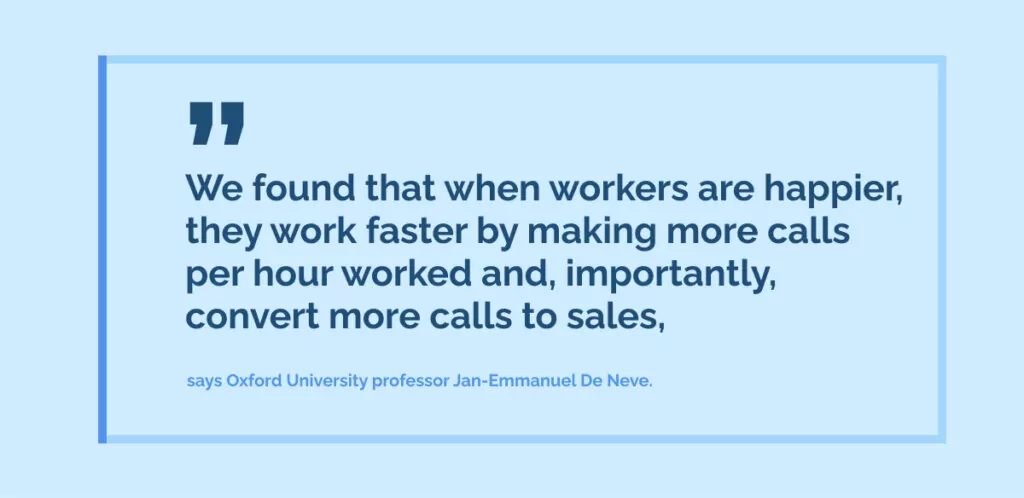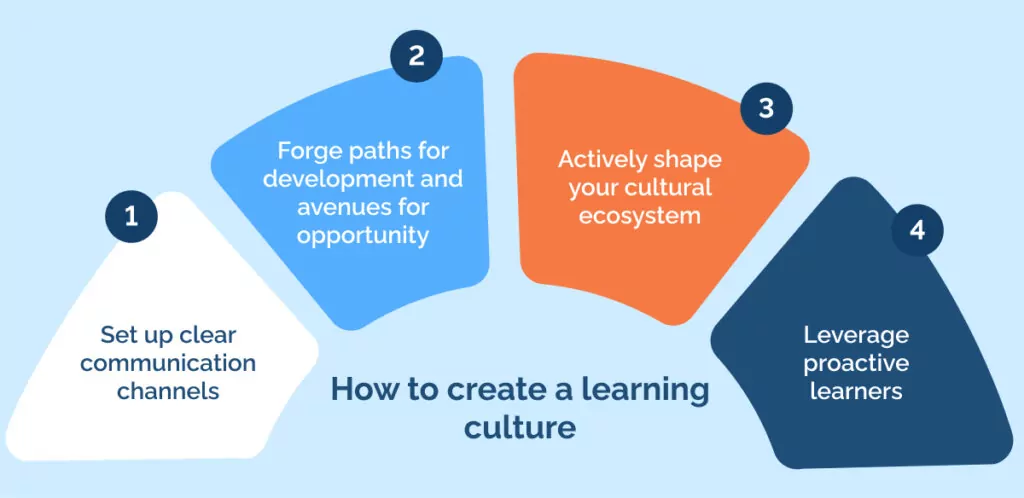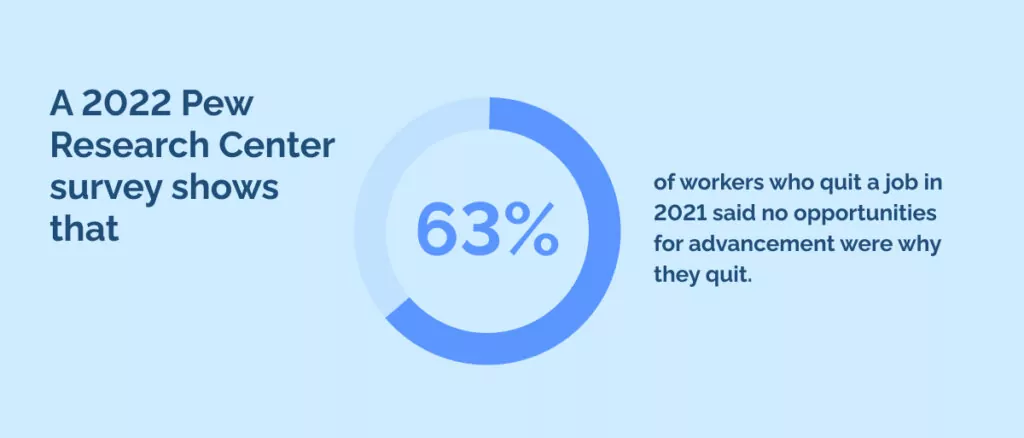
According to Oxford University, cultivating a healthy learning culture correlates with increased workplace satisfaction among employees, with happy workers being 13% more productive.
Providing opportunities that focus on employee training and development contributes to a more productive workforce and addresses the increasing business demand for new skills and talent acquisition.
Increasing employee development can create a positive ripple effect across the entire business. This will enable an enhanced ability to fast-track employee performance, navigate change, scale operations, and develop new skills for driving better business outcomes.
According to Gallup, organizations with the best cultures tend to attract the top 20% of talented individuals.
This article will explore what a learning culture is, the importance of creating one in the workplace, and tips for creating environments conducive to continuous progress.
What is a learning culture?
A company culture of learning facilitates working environments where employees are provided opportunities for harnessing new skills, re-training, and expanding their knowledge regarding business objectives.
Learning cultures boost productivity and performance levels while supporting growth from both a professional and personal perspective.
The cross-section between business prerogatives and developmental learning is where a healthy learning culture thrives. Leaders must ensure that learning and development initiatives are deployed in a way that reflects organizational objectives, principles, and ambitions.
This requires securing budgetary needs and appointing a professional authority to deploy learning activities, encouraging employees on their personal development journey, and overseeing the talent management process.
Why is a learning culture important?
A future-ready organization always demonstrates adaptability, agility, and the nurturing of talent to create new value.
On the other hand, the operational immutability and unwillingness of some firms to set up learning-conducive ecosystems are sure recipes for eventual failure.
The Great Resignation witnessed a significant wave of workers leaving their jobs. It is reported that approximately 4.4 million workers in the United States resigned in 2021, which coincided with the onset of the COVID-19 pandemic. This led to a widening talent deficit, where established company cultures eroded as employee expectations shifted towards more rewarding positions.
Additionally, the rise in remote and hybrid work due to the global pandemic has led to a fractured workforce for many businesses, with traditional working models having to be recalibrated practically overnight.
Evolving external forces like these make it especially important for organizations to perpetuate a dynamic learning culture and attract and retain talent that defines today’s future-ready firms.
According to research from the Association for Talent Development and the Institute for Corporate Productivity, organizations with a strong learning culture are more likely to produce outstanding business results. These companies are leaders in revenue growth, profitability, market share, and customer satisfaction.
What are the benefits of a learning culture?

Cultivating a strong and positive culture within an organization offers a variety of benefits that can enhance productivity and employee satisfaction while enabling organizations to respond to external factors in an agile and adaptable way.
“We found that when workers are happier, they work faster by making more calls per hour worked and, importantly, convert more calls to sales,” says Oxford University professor Jan-Emmanuel De Neve.

Let’s delve into some key advantages of establishing an organizational learning culture:
Enhanced Adaptability and Innovation
Organizations that prioritize learning are better equipped to adapt to evolving market conditions. Encouraging employees to actively seek new knowledge and skills fosters a mindset of innovation and agility within companies.
This enables them to embrace emerging trends, capture opportunities, and outmaneuver competitors.
Increased Employee Engagement and Talent Retention
A learning culture empowers employees to develop and grow both personally and professionally. When individuals feel supported and encouraged to expand their knowledge and skill sets, they become more engaged in their work.
This fosters a sense of loyalty and commitment, leading to higher employee retention rates.
Improved Performance and Productivity
Employees who consistently engage in learning experiences are more motivated and productive. By acquiring new knowledge and skills, they become more adept at their jobs, which boosts overall performance.
A learning culture also promotes a growth mindset, encouraging employees to seek creative solutions and think outside the box to drive productivity.
Effective Talent Development and Succession Planning
Cultivating a learning culture is essential for effective talent development. When employees have continuous learning opportunities, organizations can identify and nurture high-potential individuals for future leadership roles.
This proactive approach to succession planning ensures a pipeline of capable leaders who can guide the organization through future challenges.
Enhanced Organizational Resilience
Learning cultures promote a culture of continuous improvement, enabling organizations to adapt and thrive in dynamic environments. Companies develop resilience and the ability to bounce back stronger after setbacks by instilling a willingness to learn from failures and mistakes.
This resilience becomes a competitive advantage in an ever-changing business landscape.
Knowledge Sharing and Collaboration
Knowledge sharing becomes a natural part of everyday operations in organizations with a strong learning culture. Employees are encouraged to share their expertise and insights, fostering collaboration and cross-functional learning.
This collective knowledge drives innovation, problem-solving, and the organization’s growth.
Attracting Top Talent
Organizations known for their commitment to learning and development attract top talent. Job seekers increasingly prioritize opportunities for growth and continuous learning when choosing potential employers.
By cultivating a learning culture, companies can position themselves as desirable workplaces that invest in their employees’ professional development.
How to create a learning culture

Creating a healthy learning culture within an organization requires a strategic approach consisting of several foundational elements.
Whether that be ensuring a safe space for communication or setting up development programs, by focusing on the following areas, organizations can fuel learning cultures where employees are empowered to reach their full potential and drive maximum value.
1. Set up clear communication channels
Clear communication is fundamental in establishing a healthy learning culture. Leaders should facilitate an environment where healthy discourse and discussions may be raised and addressed.
According to Gallup, a mere 13% of U.S. workers strongly agree that their organization’s leadership communicates effectively.
This means encouraging employees to express thoughts, ideas, and opinions freely without fear of pushback or the perception of failure hanging over their heads.
Communication is a two-way street, where learning leaders must actively listen to employees and value diverse opinions. Conversely, leaders must ensure their authority is respected and realized, which can be achieved through trust-building.
This way, leaders can ensure that L&D efforts produce outcomes that align with an organization’s goals and values.
2. Forge paths for development and avenues for opportunity
To facilitate value creation through healthy learning cultures, organizations must actively forge paths for employee development and avenues for growth.

A 2022 Pew Research Center survey shows that 63% of workers who quit a job in 2021 said no opportunities for advancement were why they quit.
This means investing in and providing a range of learning resources, such as online courses, workshops, mentorship programs, and access to industry conferences or webinars. These resources enable employees to acquire new skills and expand their knowledge base.
Organizations can also create clear and transparent career pathways, mapping out opportunities that guide employee growth and advancement. This allows employees to envision their future within the organization and motivates them to pursue continuous learning.
Additionally, encouraging employees to create personal development plans helps align their aspirations with organizational goals. Empowering employees to take ownership of their growth and utilize their talents fosters a sense of autonomy and investment in their professional development.
3. Actively shape your cultural ecosystem
According to a Glassdoor survey, over 77% of adults across the United States, UK, France, and Germany would consider a company’s culture before applying for a job there.
Additionally, 79% of respondents said they would consider a company’s mission and purpose before applying. These stats confirm that creating a healthy learning culture should be firmly within the purview of organizations.
Simply aspiring to achieve a healthy learning culture is not enough. Organizations must actively shape their cultural ecosystems. This involves determining what a dynamic work culture means to you and how it will translate to the environment.
It may mean gaining consensus across teams on changes they aspire to see regarding business principles and objectives and putting them into action.
Additional solutions may involve:
- Leading by example: Leaders should model a commitment to continuous learning by actively participating in learning initiatives, sharing their experiences, and demonstrating the value of ongoing development.
- Recognizing and celebrating learning achievements: Organizations should celebrate and recognize employees’ learning achievements. This can be done through awards, acknowledgments, or public recognition, reinforcing the importance of learning within the organizational culture.
- Creating a safe and inclusive environment: A healthy learning culture requires an environment where employees feel safe to take risks, ask questions, and share their knowledge. Organizations should proactively foster inclusivity, respect diverse perspectives, and encourage collaboration.
4. Leverage proactive learners
Identifying and leveraging proactive learners can significantly contribute to a healthy learning culture, especially in fast-paced environments where change is constant.
Research from the CCL shows that the most successful leaders with the longest careers have the key leadership trait of learning agility.
The digital transformation era, along with several external factors (I.e., geopolitical tensions, supply chain disruptions, and global pandemics), ensures that sustained learning, such as upskilling and reskilling, will be increasingly necessary for companies to remain agile.
Transferable and soft skills are in demand more than ever due to unpredictable and sudden transformations in business models.
Today’s business must keep their finger on the pulse of industry changes and demonstrate maneuverability at short notice. This creates a need for proactive and agile learners who can leverage cross-functional problem-solving skills and support prospective business capabilities.
Acquire those who aren’t afraid to think innovatively and challenge norms. Seek agile candidates who can learn from their wins and losses and use their experiences to improve the outcomes of future attempts.
Embrace a learning culture and see the impact
Ultimately, cultivating a healthy learning culture serves as a means of organizational future-proofing, with an understanding that achieving sustainable growth is dependent on the value generated by top-performing employees.
This way, implementing learning and development (L&D) mechanisms enriches and fortifies organizational culture in a way that easily navigates external influences, such as turbulent market conditions.
It’s wise for organizational leaders to understand that building a learning culture rarely succeeds using a one-size-fits-all solution. Performance and capability levels vary across teams and departments, so deploying bespoke L&D opportunities tailored to an employee’s unique requirements and preferences is recommended.
Leverage data-driven insights to assess the scope and scale of prospective capabilities needed for long-term efficacy. This will provide L&D leaders with a tangible method for determining what is and what isn’t working and how to adjust the learning culture strategy accordingly.
The nature of each organization is unique, with operational output and scale varying widely, where enhanced L&D opportunities may or may not currently be a priority. Ultimately, achieving an agile learning culture should remain in the interest of organizations aiming to pioneer their domain.
While investing in learning cultures may be viewed as a holistic effort that bears no immediate actionable (I.e., improvements to profitability), doing so sets the stage and delivers the concrete components needed for long-term success.
WalkMe Team
WalkMe spearheaded the Digital Adoption Platform (DAP) for associations to use the maximum capacity of their advanced resources. Utilizing man-made consciousness, AI, and context-oriented direction, WalkMe adds a powerful UI layer to raise the computerized proficiency, everything being equal.



